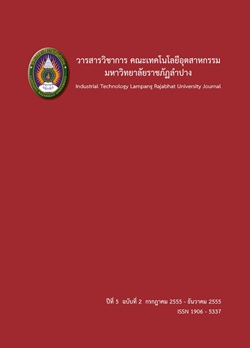อิทธิพลของตัวแปรในกระบวนการฉีดผสมหล่อขึ้นรูปต่อสมบัติความแข็งของวัสดุ เชิงประกอบพื้นอะลูมิเนียมผสมเสริมแรงด้วยอนุภาคซิลิคอนคาร์ไบด์
Keywords:
วัสดุเชิงประกอบพื้นอะลูมิเนียม, อนุภาคซิลิคอนคาร์ไบด์, การฉีดผสมหล่อขึ้นรูป, aluminum composites, SiCp, particulate-injection castingAbstract
การวิจัยครั้งนี้ศึกษาอิทธิพลของตัวแปรในกระบวนการฉีดผสมหล่อขึ้นรูปที่ส่งผลต่อสมบัติ ความแข็งของวัสดุเชิงประกอบพื้นอะลูมิเนียมเกรด A356 ซึ่งจะทำการเปรียบเทียบความแข็งชิ้นงาน หล่อที่เสริมแรงด้วยอนุภาคซิลิคอนคาร์ไบด์ที่ร้อยละ 10 โดยน้ำหนักกับความแข็งชิ้นงานหล่อที่ไม่ได้ เสริมแรงด้วยอนุภาคของซิลิคอนคาร์ไบด์และได้ทำการปรับใช้เครื่องกำจัดแก๊สไฮโดรเจนเคลื่อนที่ พร้อมอุปกรณ์ฉีดอนุภาคซิลิคอนคาร์ไบด์ผ่านท่อแกรไฟต์ด้วยแก๊สอาร์กอนลงสู่โลหะอะลูมิเนียม ผสมกึ่งแข็งที่อุณหภูมิกวนผสม 590 องศาเซลเซียส โดยใช้ความเร็วการปั่นผสม คือ 1,000 รอบต่อนาที และใช้เวลาฉีดปั่นผสม 20 นาที สำหรับตัวแปรควบคุมในงานวิจัยนี้ ได้แก่ 1) อุณหภูมิเทขึ้นรูป คือ 620 และ 680 องศาเซลเซียส 2) อัตราการไหลของแก๊สอาร์กอนที่ 5 และ 10 ลิตรต่อนาที ชิ้นงานหล่อ ที่ได้จะถูกนำมาตรวจสอบลักษณะโครงสร้างจุลภาคด้วยกล้องจุลทรรศน์แบบแสง และทำการทดสอบ สมบัติความแข็งแบบบริเนล ซึ่งผลการวิจัยพบว่าการขึ้นรูปวัสดุเชิงประกอบพื้นอะลูมิเนียมเสริมแรง ด้วยอนุภาคซิลิคอนคาร์ไบด์ โดยใช้อัตราการไหลของแก๊สอาร์กอนในการฉีดปั่นผสมที่ 5 ลิตรต่อนาที และเทขึ้นรูปชิ้นงานหล่อที่อุณหภูมิเท 680 องศาเซลเซียส เป็นเงื่อนไขที่เหมาะสมที่สุดสำหรับการศึกษา ครั้งนี้ที่ส่งผลทำให้ค่าความแข็งของวัสดุเชิงประกอบพื้นอะลูมิเนียมผสมเสริมแรงด้วยอนุภาค ซิลิคอนคาร์ไบด์ มีค่าเท่ากับ 77.77 BHN
Influence of process parameters on hardness property of Al-SiCp composite fabricated by particulate-injection casting
This research studied the influence of process parameters on the hardness of particulate-injection casting of SiCp-reinforced 356 aluminum composites. A comparison was made between the unreinforced and reinforced alloy (10% SiCp wt). The SiCp injection was carried out via argon gas through a graphite shaft into the semi-solid aluminum at 590°C and with a stirring speed of 1000 rpm (for 20 minutes). This was by using a modified hydrogen degassing machine prior to pouring into cylindrical permanent moulds. The process parameters studied were i) casting temperatures (620 and 680°C) and ii) argon gas flow rate (5 and 10 l/min). Microstructure examination was carried out using a digitized optical microscope. Brinell hardness was investigated to reveal the effects of powder-injection casting on the hardness of the aluminum composites. This experiment found that an argon gas flow of l/min and a casting temperature of 680°C were the optimal conditions (giving a maximum hardness of 77.77 BHN).






